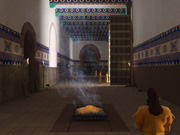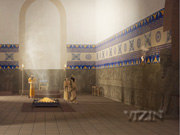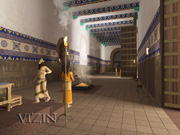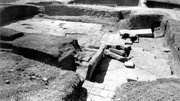The Citadel at Nimrud/Kalhu Assyria (Iraq) |
...By Any Other Name
The site of Nimrud is located in northern Iraq, on the east bank of the Tigris River, southeast of the city of Mosul, 350 km north of Baghdad. Called Kalhu in ancient times (Calah in the Bible), the city prospered in the Neo-Assyrian period after Ashur-nasir-pal II (883–859 BCE) made it an Assyrian capital. Although the royal capital was moved to Khorsabad by Sargon (721-705 BCE), Nimrud remained an important city for another century, until its destruction by the Median armies moving in from what is today Iran.
The remains of the city within the walls cover some 889 acres (about 360 hectares, or 1.4 sq miles) and are dominated by a citadel on which were built several palaces, temples, and the private houses of important officials. Today, the major palaces are called by names simply indicating their relative positions on the citadel.
- Northwest Palace (built primarily by Ashur-nasir-pal II, 883-859 BCE)
- Central Palace (Tiglath-Pileser III, 744-727 BCE)
- Southeast Palace (Shalmaneser III, 858-824 BCE)
- Southwest Palace (Esarhaddon, 7th century BCE)
Calling Attention
Most significant for our knowledge of Assyrian culture are the Northwest Palace (the largest and the most extensively excavated) and the Central Palace (important for its bas-relief decoration, but so ruined that, basically, only the reliefs are known). The Southeast Palace and Southwest Palace have been only partially excavated. Also at Nimrud are a ziggurat, an arsenal (in the lower town across the city from the ziggurat), temples, and residential areas (these last mostly unexcavated).Nimrud was first brought to the attention of interested Europeans when the British explorer Sir Austen Henry Layard found the site in the late 1840s, brought home numerous artifacts and architectural pieces, and in 1849 published his popular book Nineveh and its Remains. (It was a few years later that H. C. Rawlinson determined the site was ancient Kalhu, not Nineveh.) Excavations were then conducted at Nimrud by the British Museum sporadically between 1854 and 1882.
It was not until 1949 that sustained archaeological work resumed at Nimrud. As a result of work done by the British School of Archaeology in Iraq and the British Museum, additional areas of the Northwest Palace were traced and mapped, doubling the previously known extent of the building. Mud brick walls and arched doorways were reconstructed, and bas-relief fragments were restored in situ.
In the 1970s, an Iraqi excavation team continued excavation of the Northwest Palace, and a Polish team documented the whole citadel site in photographs, including every sculptural relief, and surveyed the site and recorded it in plan and elevation. Iraqi work continued—including the discovery of tombs of the women of the Assyrian royal family below the Northwest Palace’s floors—until it was interrupted by the outbreak of the Gulf War in 1991. Work began again in 1995.
In the unsettled and often violent situation of the past decade in Iraq, the site of Nimrud and its museum have suffered severely from both looting and gunfire damage. Today the bas-reliefs and the restored mud brick walls continue to deteriorate because it is too dangerous for conservators to work there, even with the site now guarded 24 hours a day by the Iraqi State Organization of Antiquities.
Reference
Page Created: January 16, 2012
Page Updated: January 25, 2012
URL:
Page Author: The Institute for the Visualization of History



